MBA Dissertation: Management Problem in Leader Selection
VerifiedAdded on 2023/01/18
|91
|22023
|56
Dissertation
AI Summary
This dissertation investigates the critical issue of management problems in selecting effective leaders for key management positions within organizations. It begins by establishing the importance of effective leadership for organizational success, referencing real-world examples of leadership failures and their consequences. The research explores the impact of factors such as management's ignorance of 21st-century leadership philosophies, the absence of proper management policies, and the influence of organizational culture on the selection process. The methodology employs qualitative analysis techniques to gather and analyze survey results. The findings highlight the need for organizations to prioritize the selection of leaders who align with the overall strategic goals of the firm and are provided with the appropriate responsibilities. The dissertation includes detailed data analysis, statistical interpretations, and recommendations for corporate-level and daily operational improvements. The study also suggests changes in firm policies to enhance the leader selection process, ensuring that organizations can achieve long-term success by effectively identifying and nurturing leadership talent. The dissertation offers a comprehensive overview of the challenges and solutions related to leadership selection, providing valuable insights for both academics and practitioners.
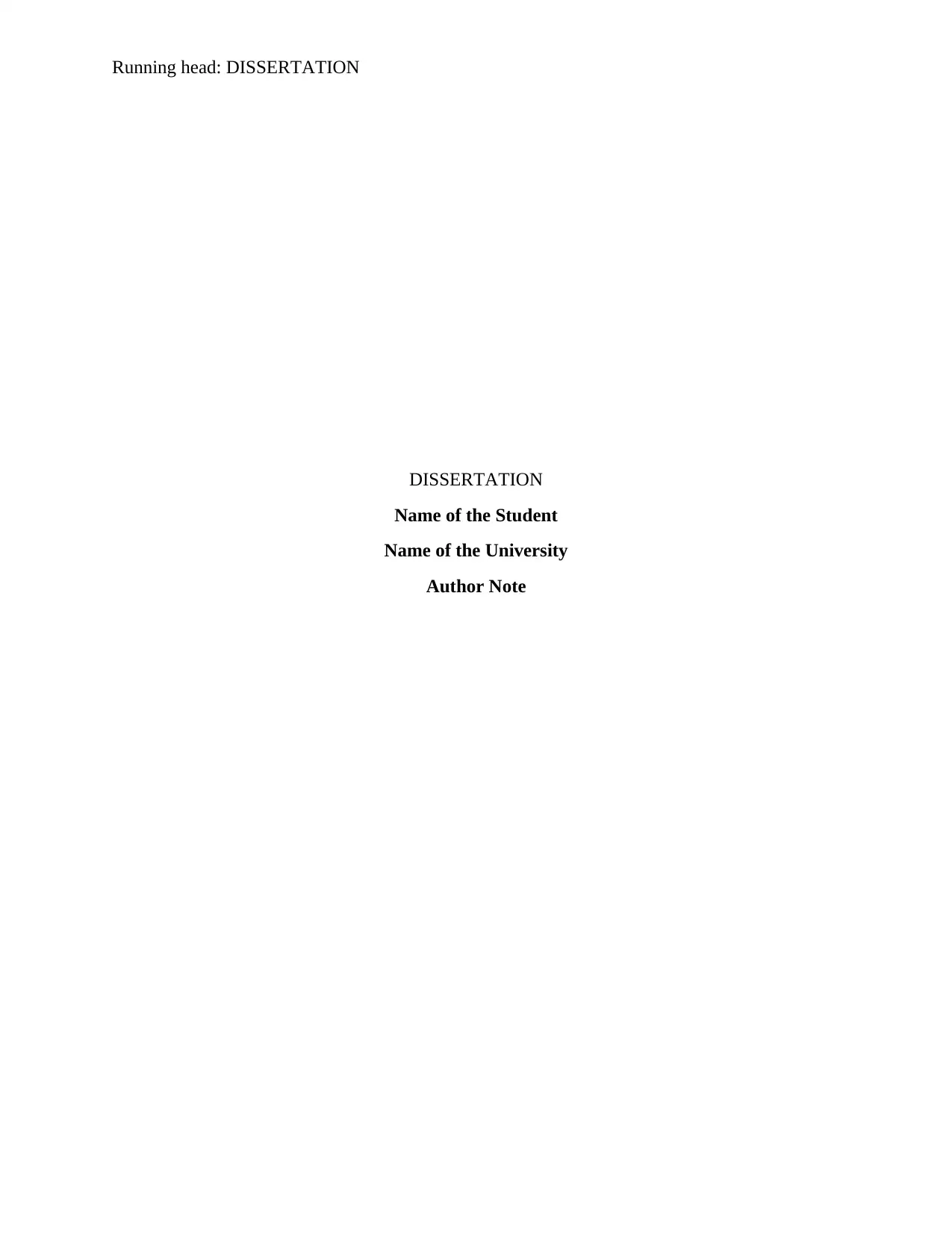
Running head: DISSERTATION
DISSERTATION
Name of the Student
Name of the University
Author Note
DISSERTATION
Name of the Student
Name of the University
Author Note
Paraphrase This Document
Need a fresh take? Get an instant paraphrase of this document with our AI Paraphraser
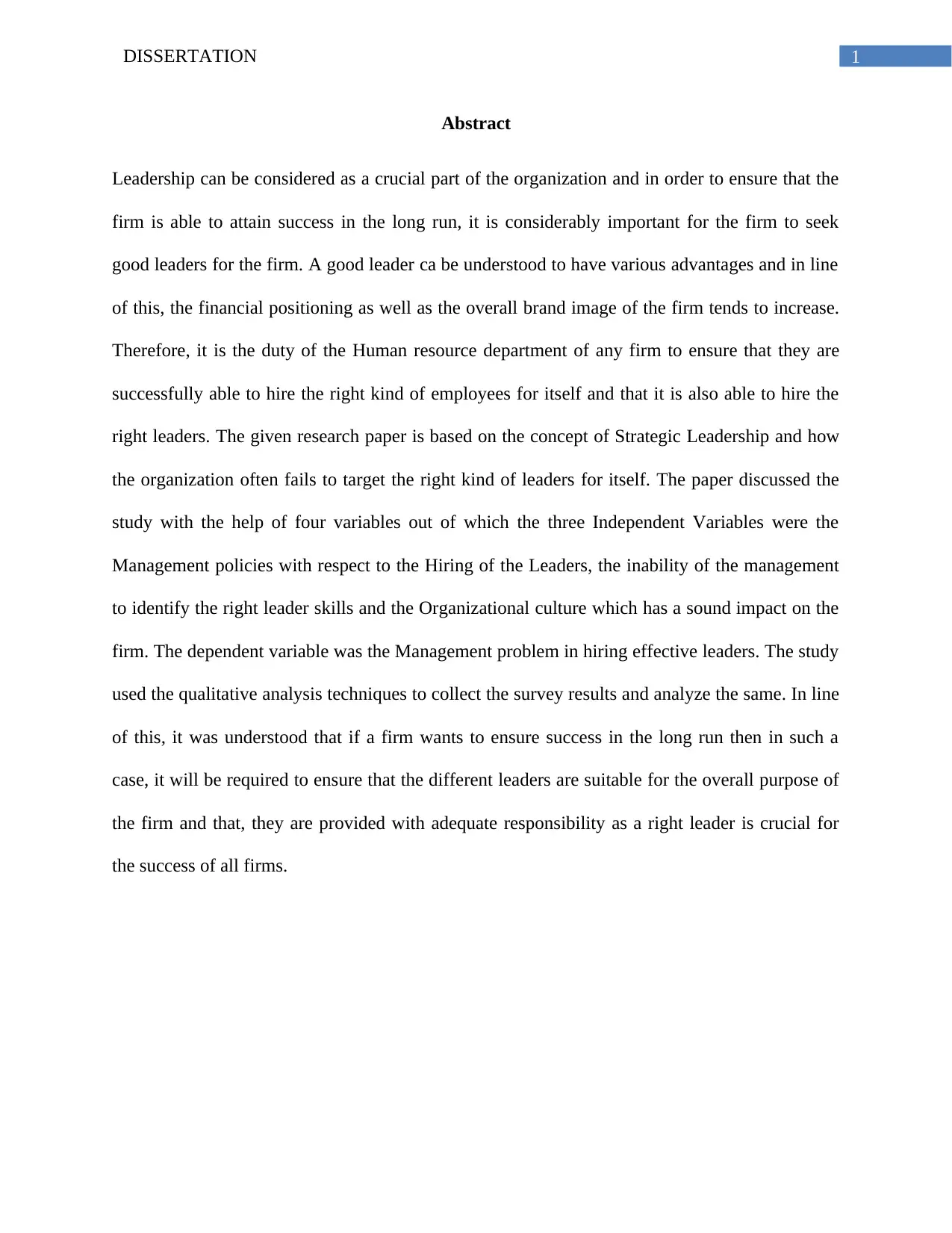
1DISSERTATION
Abstract
Leadership can be considered as a crucial part of the organization and in order to ensure that the
firm is able to attain success in the long run, it is considerably important for the firm to seek
good leaders for the firm. A good leader ca be understood to have various advantages and in line
of this, the financial positioning as well as the overall brand image of the firm tends to increase.
Therefore, it is the duty of the Human resource department of any firm to ensure that they are
successfully able to hire the right kind of employees for itself and that it is also able to hire the
right leaders. The given research paper is based on the concept of Strategic Leadership and how
the organization often fails to target the right kind of leaders for itself. The paper discussed the
study with the help of four variables out of which the three Independent Variables were the
Management policies with respect to the Hiring of the Leaders, the inability of the management
to identify the right leader skills and the Organizational culture which has a sound impact on the
firm. The dependent variable was the Management problem in hiring effective leaders. The study
used the qualitative analysis techniques to collect the survey results and analyze the same. In line
of this, it was understood that if a firm wants to ensure success in the long run then in such a
case, it will be required to ensure that the different leaders are suitable for the overall purpose of
the firm and that, they are provided with adequate responsibility as a right leader is crucial for
the success of all firms.
Abstract
Leadership can be considered as a crucial part of the organization and in order to ensure that the
firm is able to attain success in the long run, it is considerably important for the firm to seek
good leaders for the firm. A good leader ca be understood to have various advantages and in line
of this, the financial positioning as well as the overall brand image of the firm tends to increase.
Therefore, it is the duty of the Human resource department of any firm to ensure that they are
successfully able to hire the right kind of employees for itself and that it is also able to hire the
right leaders. The given research paper is based on the concept of Strategic Leadership and how
the organization often fails to target the right kind of leaders for itself. The paper discussed the
study with the help of four variables out of which the three Independent Variables were the
Management policies with respect to the Hiring of the Leaders, the inability of the management
to identify the right leader skills and the Organizational culture which has a sound impact on the
firm. The dependent variable was the Management problem in hiring effective leaders. The study
used the qualitative analysis techniques to collect the survey results and analyze the same. In line
of this, it was understood that if a firm wants to ensure success in the long run then in such a
case, it will be required to ensure that the different leaders are suitable for the overall purpose of
the firm and that, they are provided with adequate responsibility as a right leader is crucial for
the success of all firms.
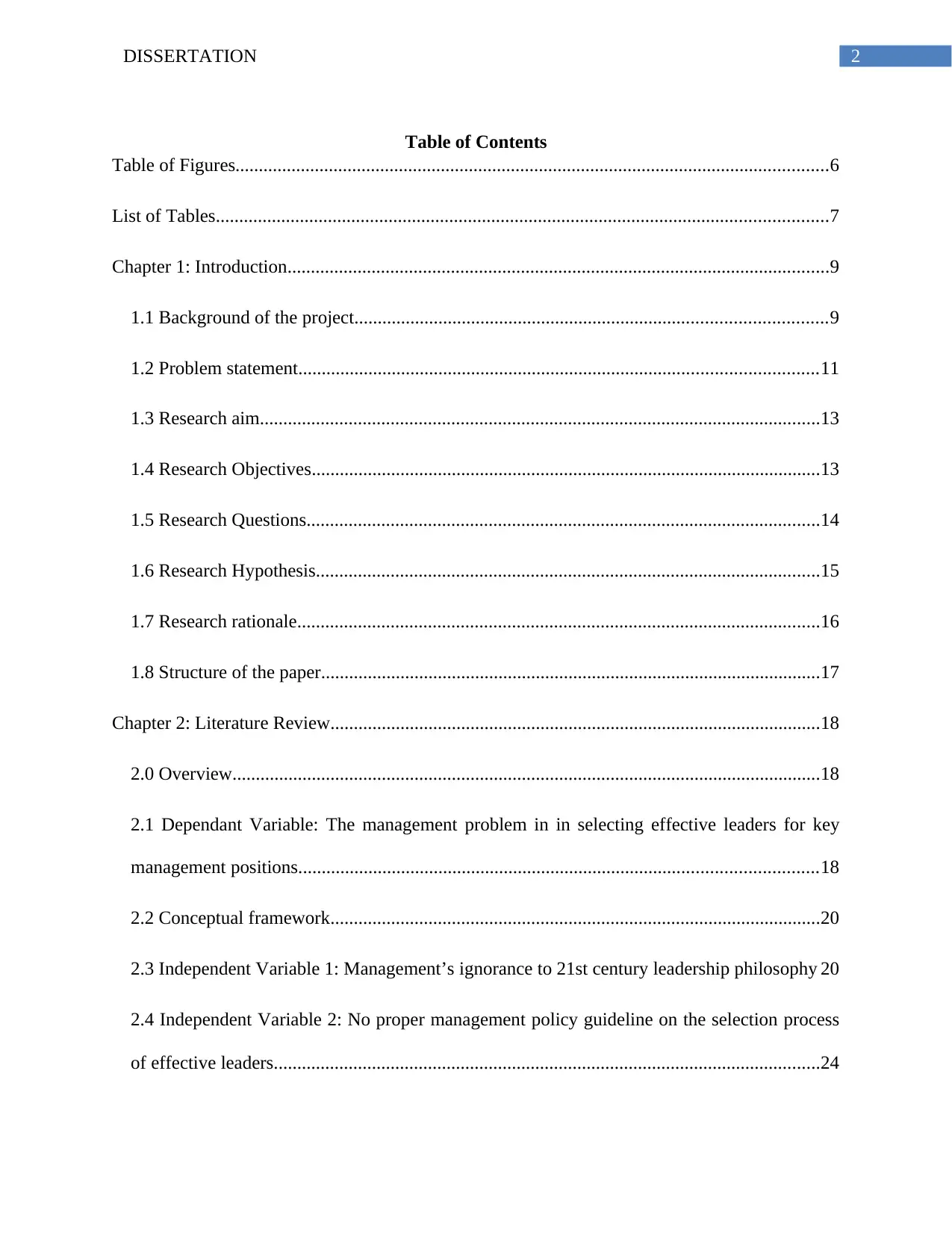
2DISSERTATION
Table of Contents
Table of Figures...............................................................................................................................6
List of Tables...................................................................................................................................7
Chapter 1: Introduction....................................................................................................................9
1.1 Background of the project.....................................................................................................9
1.2 Problem statement...............................................................................................................11
1.3 Research aim........................................................................................................................13
1.4 Research Objectives.............................................................................................................13
1.5 Research Questions..............................................................................................................14
1.6 Research Hypothesis............................................................................................................15
1.7 Research rationale................................................................................................................16
1.8 Structure of the paper...........................................................................................................17
Chapter 2: Literature Review.........................................................................................................18
2.0 Overview..............................................................................................................................18
2.1 Dependant Variable: The management problem in in selecting effective leaders for key
management positions...............................................................................................................18
2.2 Conceptual framework.........................................................................................................20
2.3 Independent Variable 1: Management’s ignorance to 21st century leadership philosophy 20
2.4 Independent Variable 2: No proper management policy guideline on the selection process
of effective leaders.....................................................................................................................24
Table of Contents
Table of Figures...............................................................................................................................6
List of Tables...................................................................................................................................7
Chapter 1: Introduction....................................................................................................................9
1.1 Background of the project.....................................................................................................9
1.2 Problem statement...............................................................................................................11
1.3 Research aim........................................................................................................................13
1.4 Research Objectives.............................................................................................................13
1.5 Research Questions..............................................................................................................14
1.6 Research Hypothesis............................................................................................................15
1.7 Research rationale................................................................................................................16
1.8 Structure of the paper...........................................................................................................17
Chapter 2: Literature Review.........................................................................................................18
2.0 Overview..............................................................................................................................18
2.1 Dependant Variable: The management problem in in selecting effective leaders for key
management positions...............................................................................................................18
2.2 Conceptual framework.........................................................................................................20
2.3 Independent Variable 1: Management’s ignorance to 21st century leadership philosophy 20
2.4 Independent Variable 2: No proper management policy guideline on the selection process
of effective leaders.....................................................................................................................24
⊘ This is a preview!⊘
Do you want full access?
Subscribe today to unlock all pages.

Trusted by 1+ million students worldwide
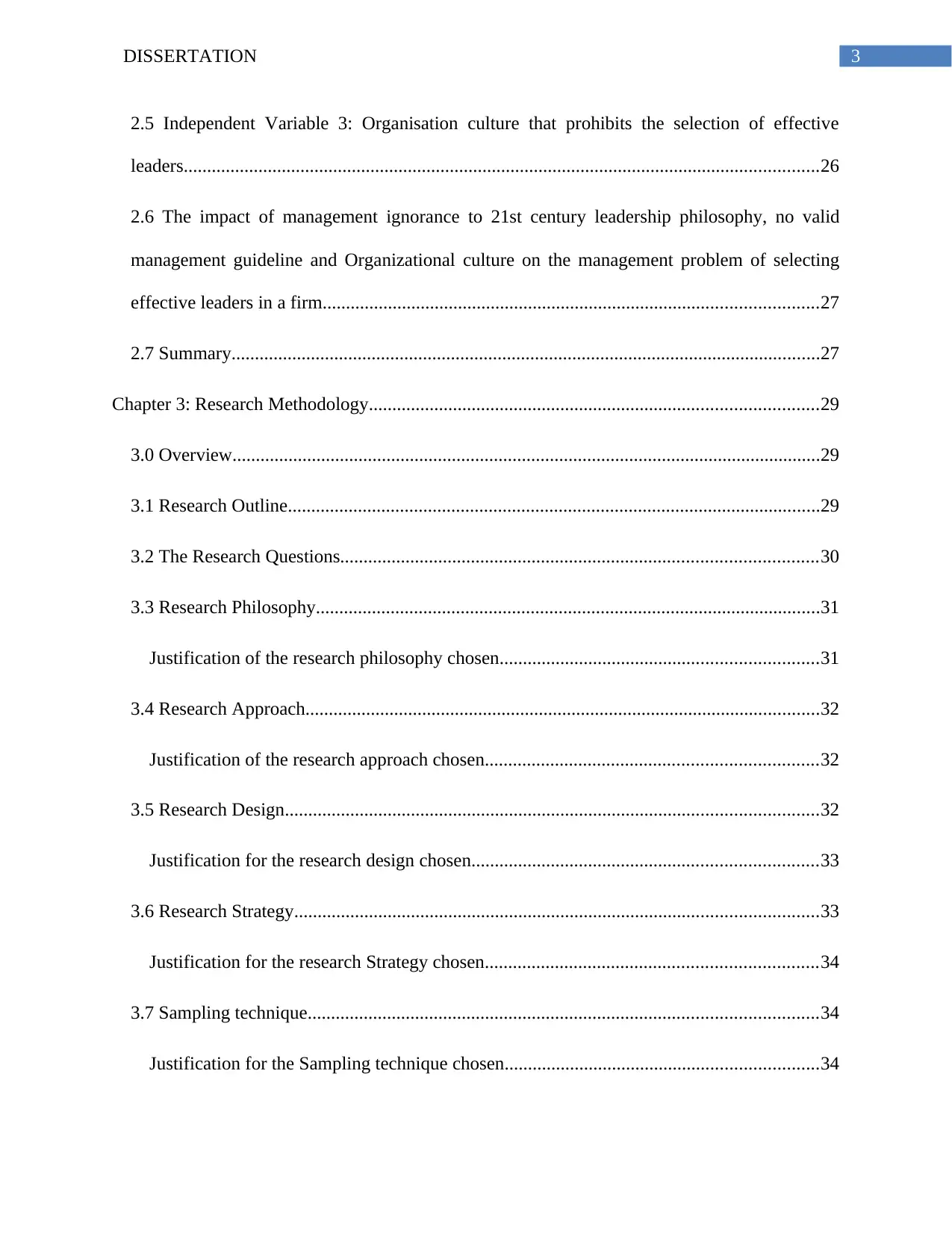
3DISSERTATION
2.5 Independent Variable 3: Organisation culture that prohibits the selection of effective
leaders........................................................................................................................................26
2.6 The impact of management ignorance to 21st century leadership philosophy, no valid
management guideline and Organizational culture on the management problem of selecting
effective leaders in a firm..........................................................................................................27
2.7 Summary..............................................................................................................................27
Chapter 3: Research Methodology................................................................................................29
3.0 Overview..............................................................................................................................29
3.1 Research Outline..................................................................................................................29
3.2 The Research Questions......................................................................................................30
3.3 Research Philosophy............................................................................................................31
Justification of the research philosophy chosen....................................................................31
3.4 Research Approach..............................................................................................................32
Justification of the research approach chosen.......................................................................32
3.5 Research Design..................................................................................................................32
Justification for the research design chosen..........................................................................33
3.6 Research Strategy................................................................................................................33
Justification for the research Strategy chosen.......................................................................34
3.7 Sampling technique.............................................................................................................34
Justification for the Sampling technique chosen...................................................................34
2.5 Independent Variable 3: Organisation culture that prohibits the selection of effective
leaders........................................................................................................................................26
2.6 The impact of management ignorance to 21st century leadership philosophy, no valid
management guideline and Organizational culture on the management problem of selecting
effective leaders in a firm..........................................................................................................27
2.7 Summary..............................................................................................................................27
Chapter 3: Research Methodology................................................................................................29
3.0 Overview..............................................................................................................................29
3.1 Research Outline..................................................................................................................29
3.2 The Research Questions......................................................................................................30
3.3 Research Philosophy............................................................................................................31
Justification of the research philosophy chosen....................................................................31
3.4 Research Approach..............................................................................................................32
Justification of the research approach chosen.......................................................................32
3.5 Research Design..................................................................................................................32
Justification for the research design chosen..........................................................................33
3.6 Research Strategy................................................................................................................33
Justification for the research Strategy chosen.......................................................................34
3.7 Sampling technique.............................................................................................................34
Justification for the Sampling technique chosen...................................................................34
Paraphrase This Document
Need a fresh take? Get an instant paraphrase of this document with our AI Paraphraser
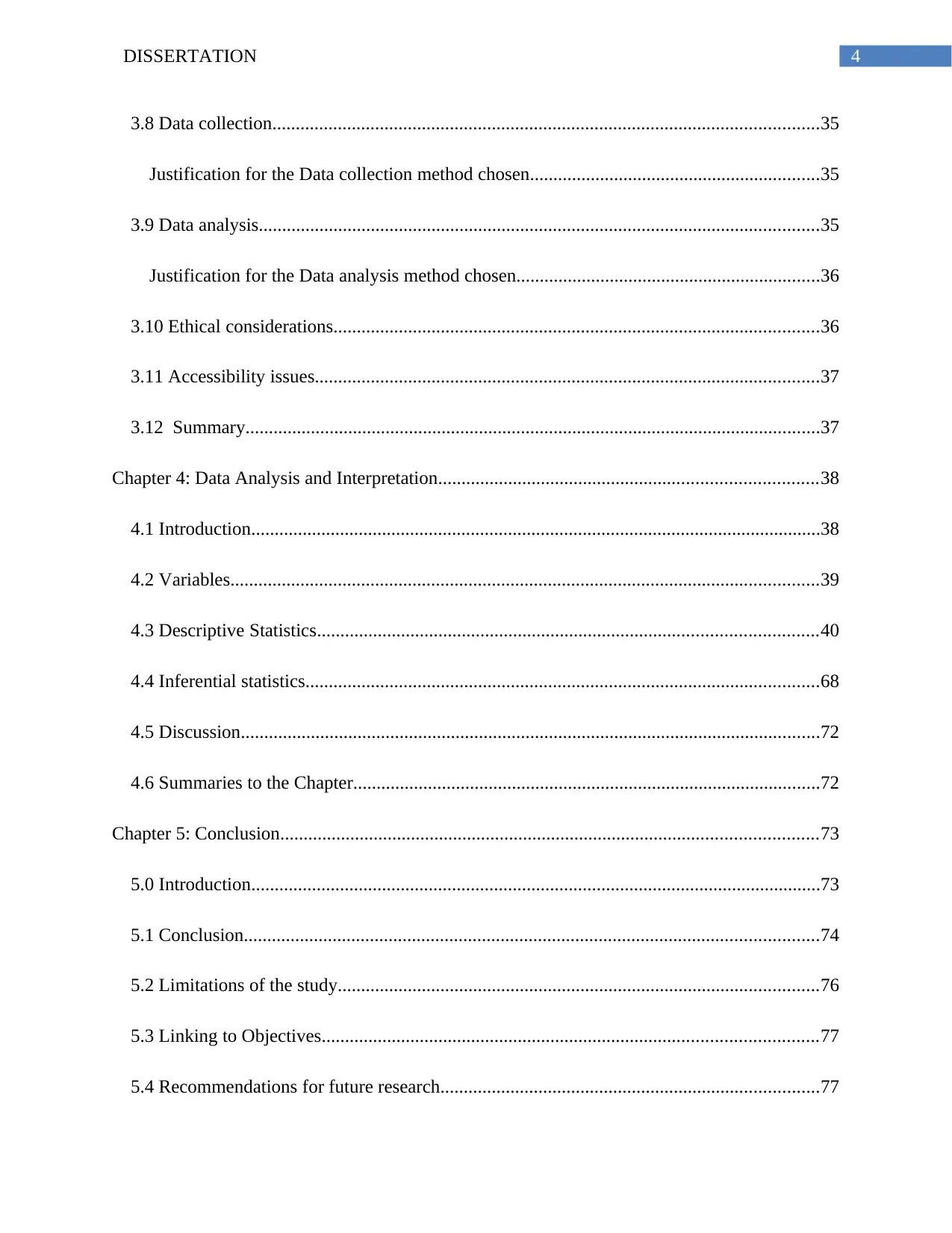
4DISSERTATION
3.8 Data collection.....................................................................................................................35
Justification for the Data collection method chosen..............................................................35
3.9 Data analysis........................................................................................................................35
Justification for the Data analysis method chosen.................................................................36
3.10 Ethical considerations........................................................................................................36
3.11 Accessibility issues............................................................................................................37
3.12 Summary...........................................................................................................................37
Chapter 4: Data Analysis and Interpretation.................................................................................38
4.1 Introduction..........................................................................................................................38
4.2 Variables..............................................................................................................................39
4.3 Descriptive Statistics...........................................................................................................40
4.4 Inferential statistics..............................................................................................................68
4.5 Discussion............................................................................................................................72
4.6 Summaries to the Chapter....................................................................................................72
Chapter 5: Conclusion...................................................................................................................73
5.0 Introduction..........................................................................................................................73
5.1 Conclusion...........................................................................................................................74
5.2 Limitations of the study.......................................................................................................76
5.3 Linking to Objectives..........................................................................................................77
5.4 Recommendations for future research.................................................................................77
3.8 Data collection.....................................................................................................................35
Justification for the Data collection method chosen..............................................................35
3.9 Data analysis........................................................................................................................35
Justification for the Data analysis method chosen.................................................................36
3.10 Ethical considerations........................................................................................................36
3.11 Accessibility issues............................................................................................................37
3.12 Summary...........................................................................................................................37
Chapter 4: Data Analysis and Interpretation.................................................................................38
4.1 Introduction..........................................................................................................................38
4.2 Variables..............................................................................................................................39
4.3 Descriptive Statistics...........................................................................................................40
4.4 Inferential statistics..............................................................................................................68
4.5 Discussion............................................................................................................................72
4.6 Summaries to the Chapter....................................................................................................72
Chapter 5: Conclusion...................................................................................................................73
5.0 Introduction..........................................................................................................................73
5.1 Conclusion...........................................................................................................................74
5.2 Limitations of the study.......................................................................................................76
5.3 Linking to Objectives..........................................................................................................77
5.4 Recommendations for future research.................................................................................77
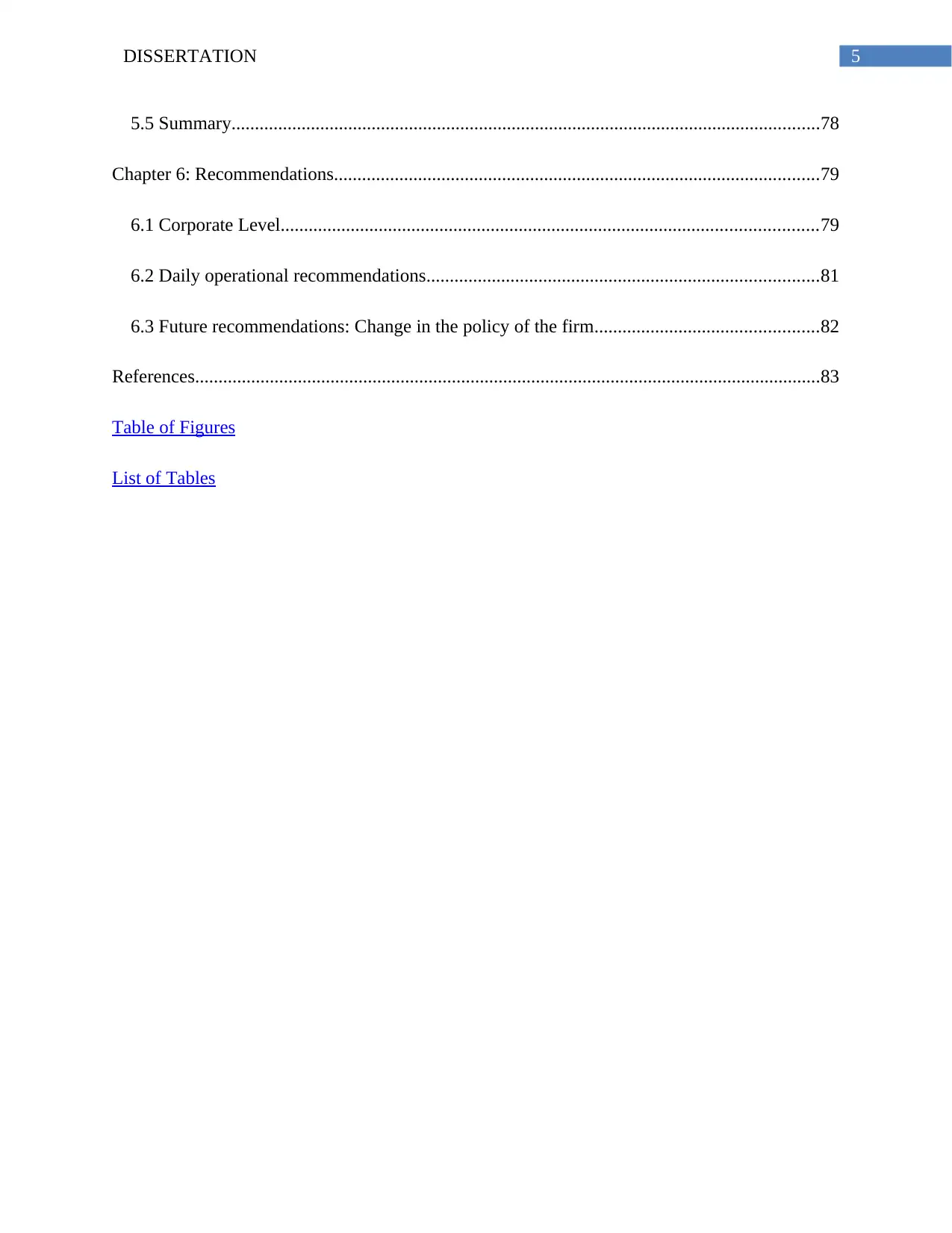
5DISSERTATION
5.5 Summary..............................................................................................................................78
Chapter 6: Recommendations........................................................................................................79
6.1 Corporate Level...................................................................................................................79
6.2 Daily operational recommendations....................................................................................81
6.3 Future recommendations: Change in the policy of the firm................................................82
References......................................................................................................................................83
Table of Figures
List of Tables
5.5 Summary..............................................................................................................................78
Chapter 6: Recommendations........................................................................................................79
6.1 Corporate Level...................................................................................................................79
6.2 Daily operational recommendations....................................................................................81
6.3 Future recommendations: Change in the policy of the firm................................................82
References......................................................................................................................................83
Table of Figures
List of Tables
⊘ This is a preview!⊘
Do you want full access?
Subscribe today to unlock all pages.

Trusted by 1+ million students worldwide
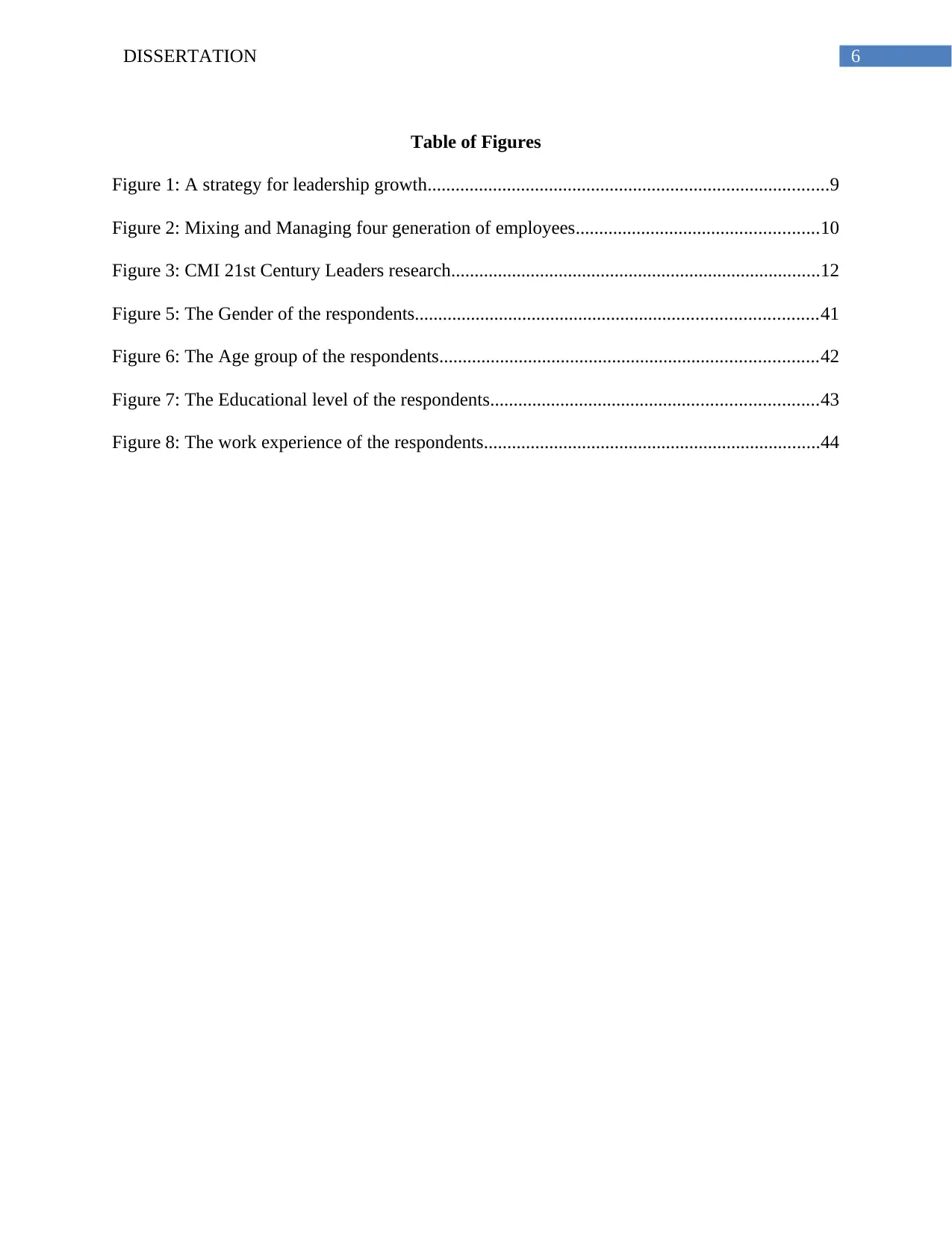
6DISSERTATION
Table of Figures
Figure 1: A strategy for leadership growth......................................................................................9
Figure 2: Mixing and Managing four generation of employees....................................................10
Figure 3: CMI 21st Century Leaders research...............................................................................12
Figure 5: The Gender of the respondents......................................................................................41
Figure 6: The Age group of the respondents.................................................................................42
Figure 7: The Educational level of the respondents......................................................................43
Figure 8: The work experience of the respondents........................................................................44
Table of Figures
Figure 1: A strategy for leadership growth......................................................................................9
Figure 2: Mixing and Managing four generation of employees....................................................10
Figure 3: CMI 21st Century Leaders research...............................................................................12
Figure 5: The Gender of the respondents......................................................................................41
Figure 6: The Age group of the respondents.................................................................................42
Figure 7: The Educational level of the respondents......................................................................43
Figure 8: The work experience of the respondents........................................................................44
Paraphrase This Document
Need a fresh take? Get an instant paraphrase of this document with our AI Paraphraser
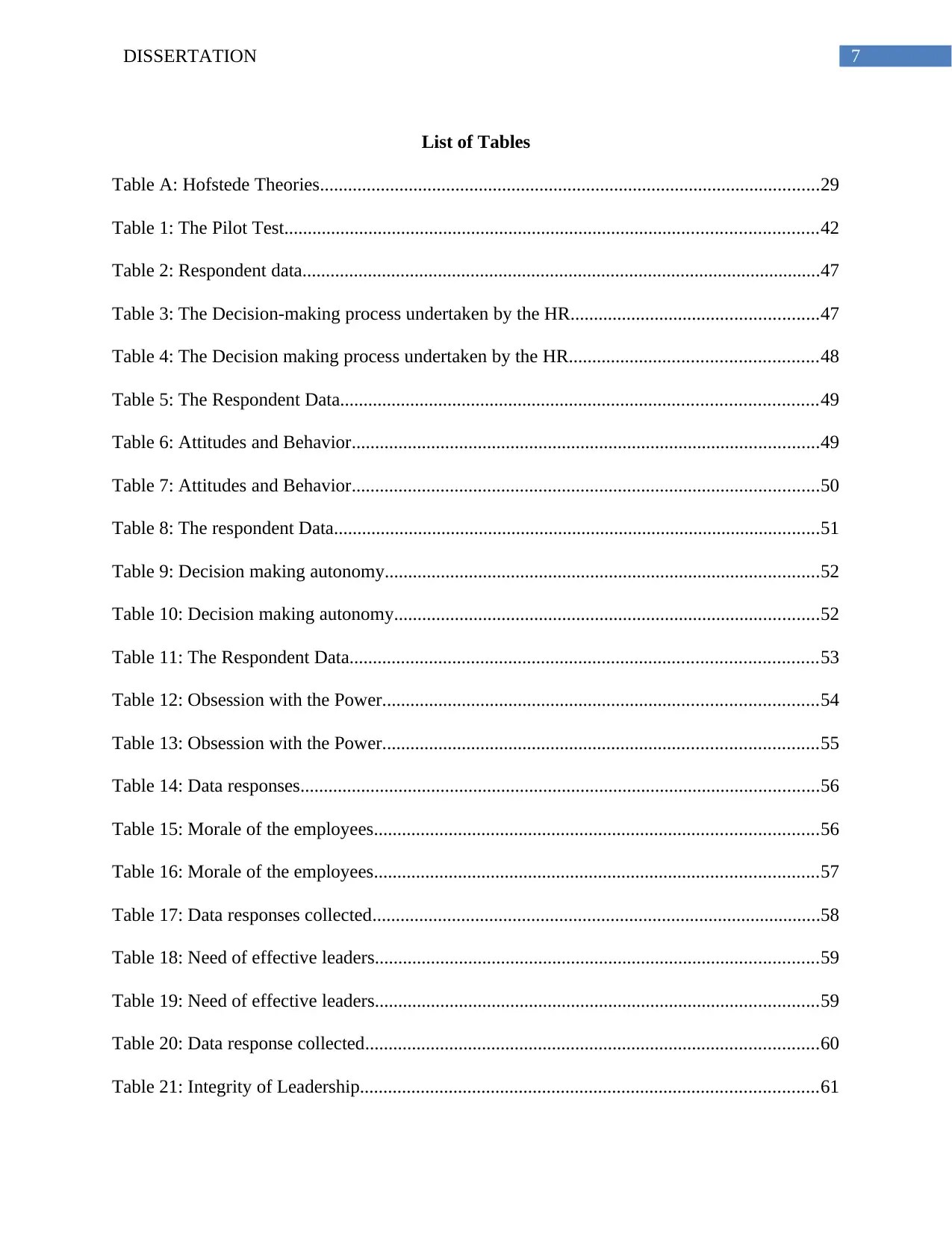
7DISSERTATION
List of Tables
Table A: Hofstede Theories...........................................................................................................29
Table 1: The Pilot Test..................................................................................................................42
Table 2: Respondent data...............................................................................................................47
Table 3: The Decision-making process undertaken by the HR.....................................................47
Table 4: The Decision making process undertaken by the HR.....................................................48
Table 5: The Respondent Data......................................................................................................49
Table 6: Attitudes and Behavior....................................................................................................49
Table 7: Attitudes and Behavior....................................................................................................50
Table 8: The respondent Data........................................................................................................51
Table 9: Decision making autonomy.............................................................................................52
Table 10: Decision making autonomy...........................................................................................52
Table 11: The Respondent Data....................................................................................................53
Table 12: Obsession with the Power.............................................................................................54
Table 13: Obsession with the Power.............................................................................................55
Table 14: Data responses...............................................................................................................56
Table 15: Morale of the employees...............................................................................................56
Table 16: Morale of the employees...............................................................................................57
Table 17: Data responses collected................................................................................................58
Table 18: Need of effective leaders...............................................................................................59
Table 19: Need of effective leaders...............................................................................................59
Table 20: Data response collected.................................................................................................60
Table 21: Integrity of Leadership..................................................................................................61
List of Tables
Table A: Hofstede Theories...........................................................................................................29
Table 1: The Pilot Test..................................................................................................................42
Table 2: Respondent data...............................................................................................................47
Table 3: The Decision-making process undertaken by the HR.....................................................47
Table 4: The Decision making process undertaken by the HR.....................................................48
Table 5: The Respondent Data......................................................................................................49
Table 6: Attitudes and Behavior....................................................................................................49
Table 7: Attitudes and Behavior....................................................................................................50
Table 8: The respondent Data........................................................................................................51
Table 9: Decision making autonomy.............................................................................................52
Table 10: Decision making autonomy...........................................................................................52
Table 11: The Respondent Data....................................................................................................53
Table 12: Obsession with the Power.............................................................................................54
Table 13: Obsession with the Power.............................................................................................55
Table 14: Data responses...............................................................................................................56
Table 15: Morale of the employees...............................................................................................56
Table 16: Morale of the employees...............................................................................................57
Table 17: Data responses collected................................................................................................58
Table 18: Need of effective leaders...............................................................................................59
Table 19: Need of effective leaders...............................................................................................59
Table 20: Data response collected.................................................................................................60
Table 21: Integrity of Leadership..................................................................................................61
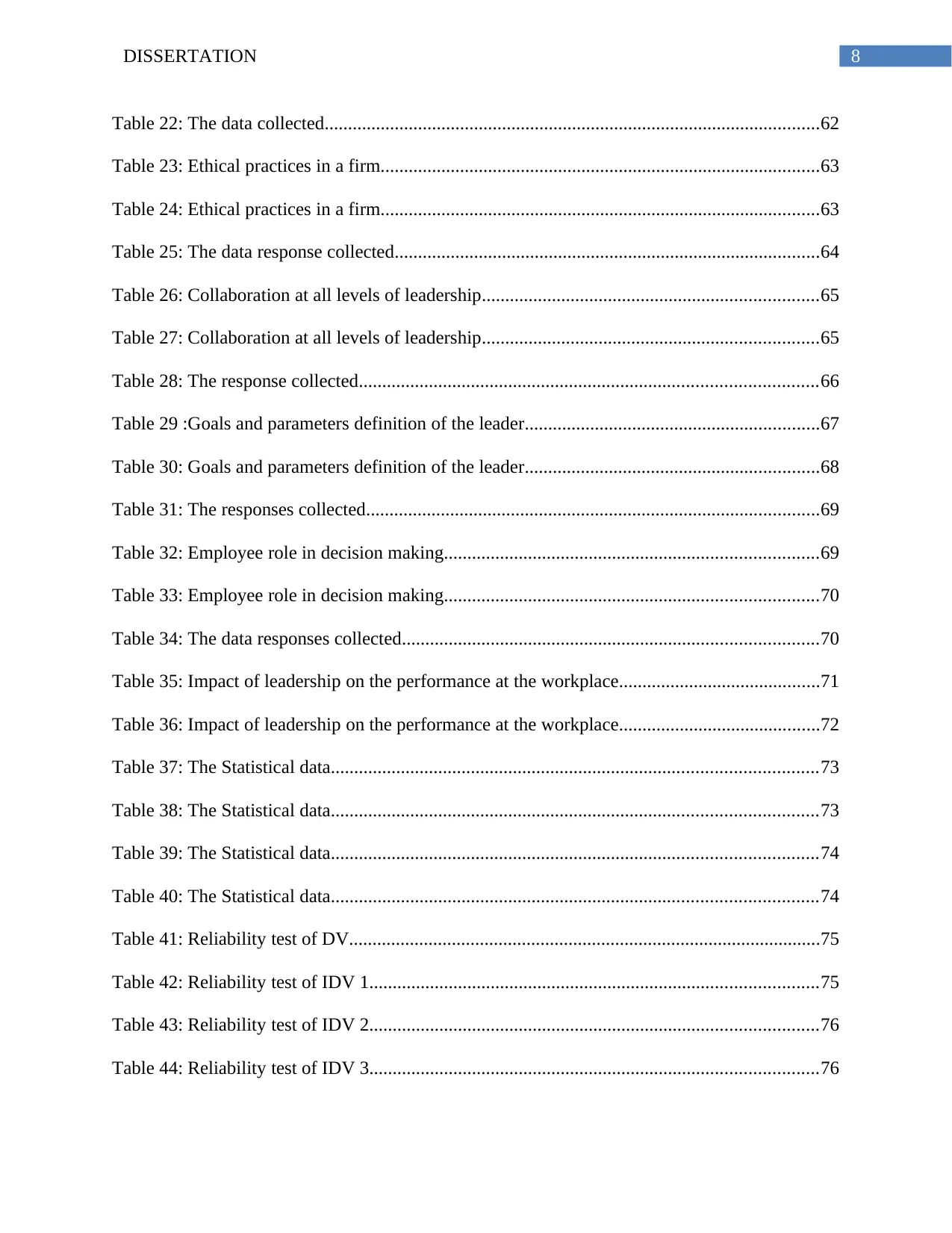
8DISSERTATION
Table 22: The data collected..........................................................................................................62
Table 23: Ethical practices in a firm..............................................................................................63
Table 24: Ethical practices in a firm..............................................................................................63
Table 25: The data response collected...........................................................................................64
Table 26: Collaboration at all levels of leadership........................................................................65
Table 27: Collaboration at all levels of leadership........................................................................65
Table 28: The response collected..................................................................................................66
Table 29 :Goals and parameters definition of the leader...............................................................67
Table 30: Goals and parameters definition of the leader...............................................................68
Table 31: The responses collected.................................................................................................69
Table 32: Employee role in decision making................................................................................69
Table 33: Employee role in decision making................................................................................70
Table 34: The data responses collected.........................................................................................70
Table 35: Impact of leadership on the performance at the workplace...........................................71
Table 36: Impact of leadership on the performance at the workplace...........................................72
Table 37: The Statistical data........................................................................................................73
Table 38: The Statistical data........................................................................................................73
Table 39: The Statistical data........................................................................................................74
Table 40: The Statistical data........................................................................................................74
Table 41: Reliability test of DV.....................................................................................................75
Table 42: Reliability test of IDV 1................................................................................................75
Table 43: Reliability test of IDV 2................................................................................................76
Table 44: Reliability test of IDV 3................................................................................................76
Table 22: The data collected..........................................................................................................62
Table 23: Ethical practices in a firm..............................................................................................63
Table 24: Ethical practices in a firm..............................................................................................63
Table 25: The data response collected...........................................................................................64
Table 26: Collaboration at all levels of leadership........................................................................65
Table 27: Collaboration at all levels of leadership........................................................................65
Table 28: The response collected..................................................................................................66
Table 29 :Goals and parameters definition of the leader...............................................................67
Table 30: Goals and parameters definition of the leader...............................................................68
Table 31: The responses collected.................................................................................................69
Table 32: Employee role in decision making................................................................................69
Table 33: Employee role in decision making................................................................................70
Table 34: The data responses collected.........................................................................................70
Table 35: Impact of leadership on the performance at the workplace...........................................71
Table 36: Impact of leadership on the performance at the workplace...........................................72
Table 37: The Statistical data........................................................................................................73
Table 38: The Statistical data........................................................................................................73
Table 39: The Statistical data........................................................................................................74
Table 40: The Statistical data........................................................................................................74
Table 41: Reliability test of DV.....................................................................................................75
Table 42: Reliability test of IDV 1................................................................................................75
Table 43: Reliability test of IDV 2................................................................................................76
Table 44: Reliability test of IDV 3................................................................................................76
⊘ This is a preview!⊘
Do you want full access?
Subscribe today to unlock all pages.

Trusted by 1+ million students worldwide

9DISSERTATION
Chapter 1: Introduction
1.1 Background of the project
Leadership can be understood to be the act of leading individual employees to attain
the overall objectives of the organisation. In line of this, it is required to be understood that a
leader can be assumed to be a political leader who is either pursuing his passion or carrying out
the procedure of Leadership for his cause. In addition to this, leading an organisation for
competition or other such purposes (Antonakis and Day 2017). The leader tends to set the
direction, build an inspiring vision and create something new which will not only encourage the
different individuals in an organisation to perform well and additionally, they will also be able to
help the various individuals to overcome the hurdles and attain their overall organisational
objectives. According to Dibra (2016), an effective leader can be understood to be an individual
who generally creates an inspiring vision of the future, motivates as well as inspires the
individuals to engage in the vision and manages the delivery of the vision as well. In the line of
this, the leader is also responsible for coaching and building various teams which would then go
a long way in ensuring that, the firm can achieve its vision successfully (Kotter 2001).
Leadership is at the centre point of the triumphs and failures of corporate organisation
around the world. In Nigeria, with the withdrawal of $15 billion by the portfolio investors from
the capital market, the Stock Exchange Market collapsed, leading to the loss of 9 trillion Naira
(Afigbo and Uya 2000). The political leader in control sees his inclusion as "bread and butter" all
things considered he wanders into profitless undertakings Corporate Leadership Failure and its
implications for the consolidation of Corporate Governance and inefficiency of public funds thus
paving the way for deceit, slothfulness, indiscipline and poverty (Habib, 1999). Nigerian
Chapter 1: Introduction
1.1 Background of the project
Leadership can be understood to be the act of leading individual employees to attain
the overall objectives of the organisation. In line of this, it is required to be understood that a
leader can be assumed to be a political leader who is either pursuing his passion or carrying out
the procedure of Leadership for his cause. In addition to this, leading an organisation for
competition or other such purposes (Antonakis and Day 2017). The leader tends to set the
direction, build an inspiring vision and create something new which will not only encourage the
different individuals in an organisation to perform well and additionally, they will also be able to
help the various individuals to overcome the hurdles and attain their overall organisational
objectives. According to Dibra (2016), an effective leader can be understood to be an individual
who generally creates an inspiring vision of the future, motivates as well as inspires the
individuals to engage in the vision and manages the delivery of the vision as well. In the line of
this, the leader is also responsible for coaching and building various teams which would then go
a long way in ensuring that, the firm can achieve its vision successfully (Kotter 2001).
Leadership is at the centre point of the triumphs and failures of corporate organisation
around the world. In Nigeria, with the withdrawal of $15 billion by the portfolio investors from
the capital market, the Stock Exchange Market collapsed, leading to the loss of 9 trillion Naira
(Afigbo and Uya 2000). The political leader in control sees his inclusion as "bread and butter" all
things considered he wanders into profitless undertakings Corporate Leadership Failure and its
implications for the consolidation of Corporate Governance and inefficiency of public funds thus
paving the way for deceit, slothfulness, indiscipline and poverty (Habib, 1999). Nigerian
Paraphrase This Document
Need a fresh take? Get an instant paraphrase of this document with our AI Paraphraser
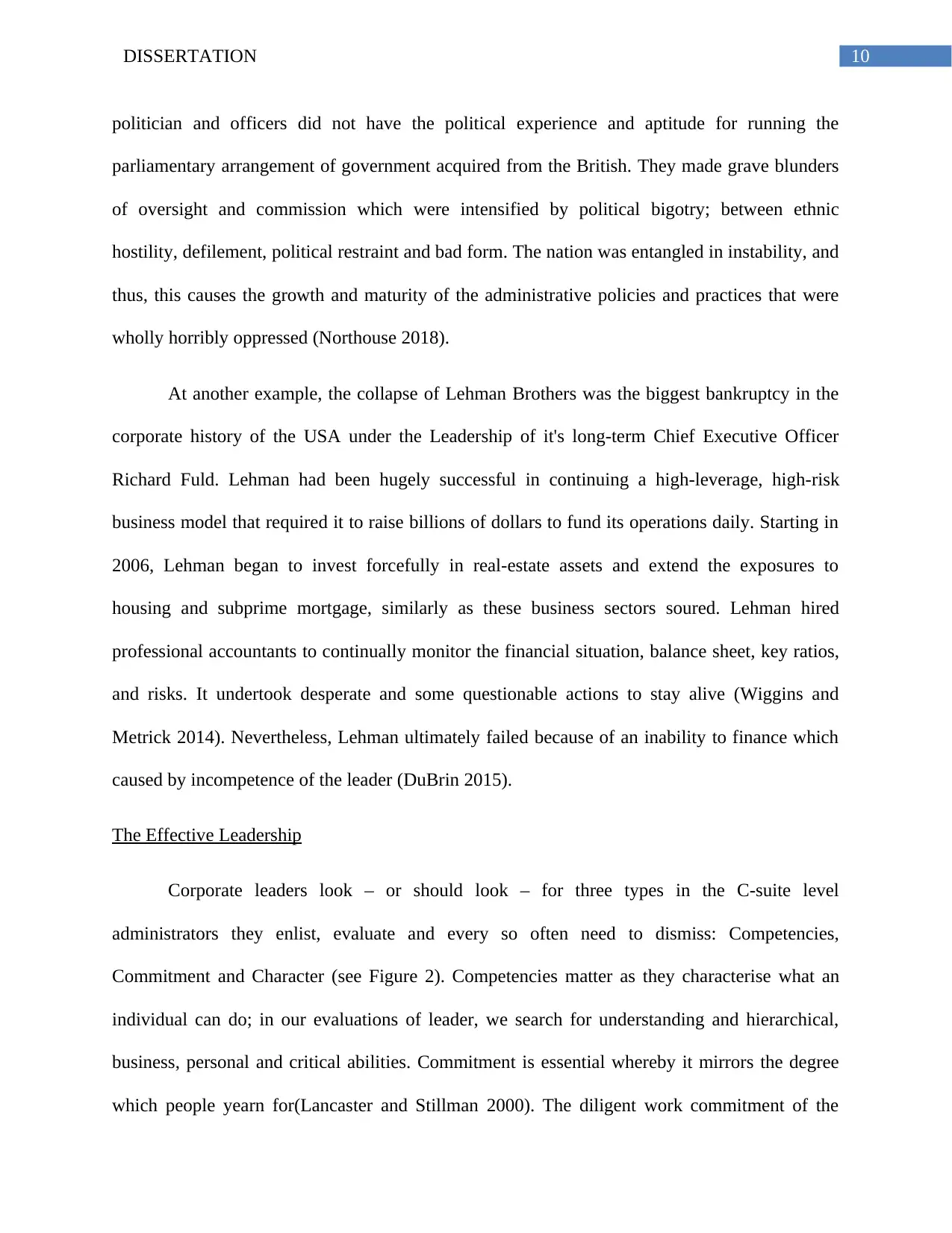
10DISSERTATION
politician and officers did not have the political experience and aptitude for running the
parliamentary arrangement of government acquired from the British. They made grave blunders
of oversight and commission which were intensified by political bigotry; between ethnic
hostility, defilement, political restraint and bad form. The nation was entangled in instability, and
thus, this causes the growth and maturity of the administrative policies and practices that were
wholly horribly oppressed (Northouse 2018).
At another example, the collapse of Lehman Brothers was the biggest bankruptcy in the
corporate history of the USA under the Leadership of it's long-term Chief Executive Officer
Richard Fuld. Lehman had been hugely successful in continuing a high-leverage, high-risk
business model that required it to raise billions of dollars to fund its operations daily. Starting in
2006, Lehman began to invest forcefully in real-estate assets and extend the exposures to
housing and subprime mortgage, similarly as these business sectors soured. Lehman hired
professional accountants to continually monitor the financial situation, balance sheet, key ratios,
and risks. It undertook desperate and some questionable actions to stay alive (Wiggins and
Metrick 2014). Nevertheless, Lehman ultimately failed because of an inability to finance which
caused by incompetence of the leader (DuBrin 2015).
The Effective Leadership
Corporate leaders look – or should look – for three types in the C-suite level
administrators they enlist, evaluate and every so often need to dismiss: Competencies,
Commitment and Character (see Figure 2). Competencies matter as they characterise what an
individual can do; in our evaluations of leader, we search for understanding and hierarchical,
business, personal and critical abilities. Commitment is essential whereby it mirrors the degree
which people yearn for(Lancaster and Stillman 2000). The diligent work commitment of the
politician and officers did not have the political experience and aptitude for running the
parliamentary arrangement of government acquired from the British. They made grave blunders
of oversight and commission which were intensified by political bigotry; between ethnic
hostility, defilement, political restraint and bad form. The nation was entangled in instability, and
thus, this causes the growth and maturity of the administrative policies and practices that were
wholly horribly oppressed (Northouse 2018).
At another example, the collapse of Lehman Brothers was the biggest bankruptcy in the
corporate history of the USA under the Leadership of it's long-term Chief Executive Officer
Richard Fuld. Lehman had been hugely successful in continuing a high-leverage, high-risk
business model that required it to raise billions of dollars to fund its operations daily. Starting in
2006, Lehman began to invest forcefully in real-estate assets and extend the exposures to
housing and subprime mortgage, similarly as these business sectors soured. Lehman hired
professional accountants to continually monitor the financial situation, balance sheet, key ratios,
and risks. It undertook desperate and some questionable actions to stay alive (Wiggins and
Metrick 2014). Nevertheless, Lehman ultimately failed because of an inability to finance which
caused by incompetence of the leader (DuBrin 2015).
The Effective Leadership
Corporate leaders look – or should look – for three types in the C-suite level
administrators they enlist, evaluate and every so often need to dismiss: Competencies,
Commitment and Character (see Figure 2). Competencies matter as they characterise what an
individual can do; in our evaluations of leader, we search for understanding and hierarchical,
business, personal and critical abilities. Commitment is essential whereby it mirrors the degree
which people yearn for(Lancaster and Stillman 2000). The diligent work commitment of the
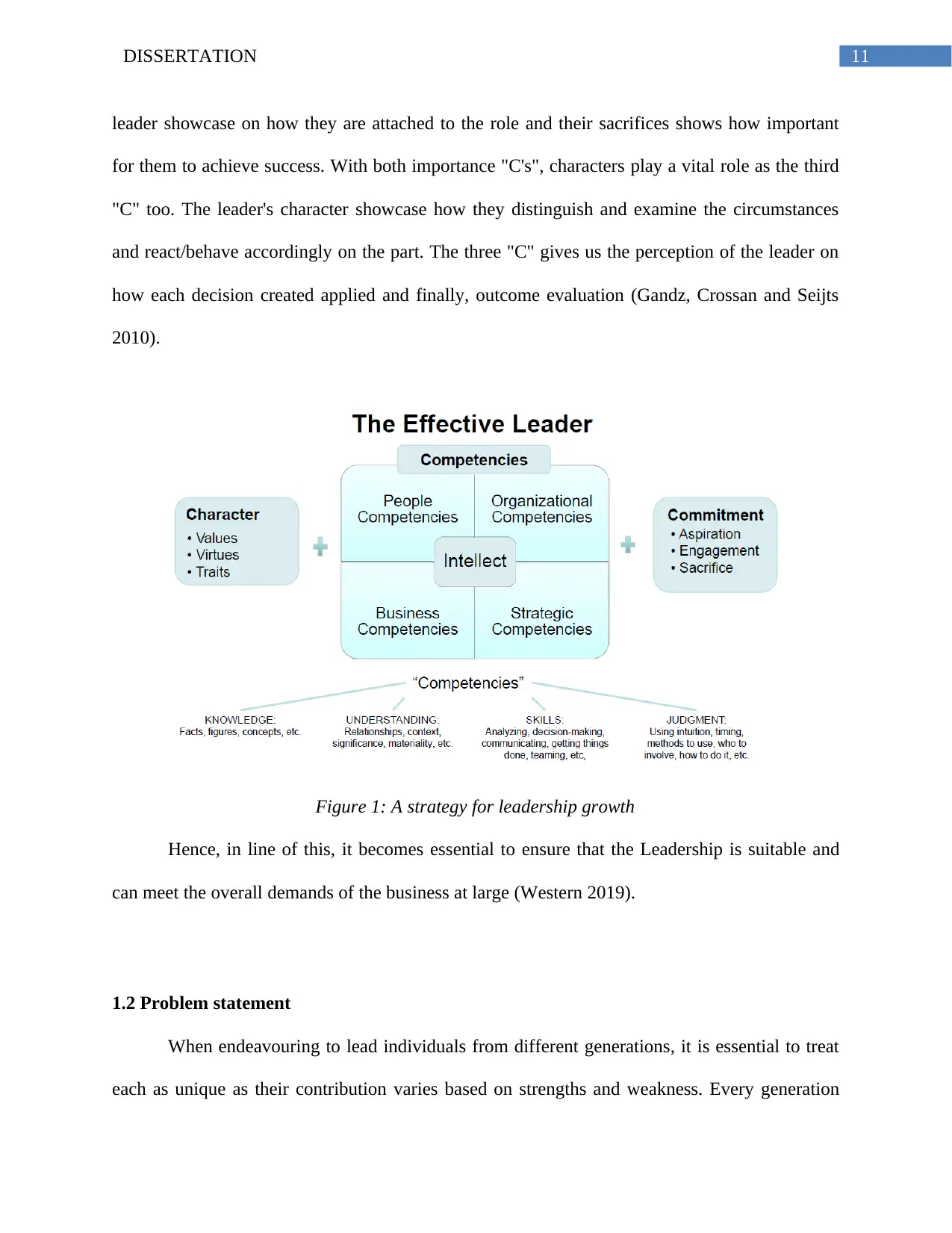
11DISSERTATION
leader showcase on how they are attached to the role and their sacrifices shows how important
for them to achieve success. With both importance "C's", characters play a vital role as the third
"C" too. The leader's character showcase how they distinguish and examine the circumstances
and react/behave accordingly on the part. The three "C" gives us the perception of the leader on
how each decision created applied and finally, outcome evaluation (Gandz, Crossan and Seijts
2010).
Figure 1: A strategy for leadership growth
Hence, in line of this, it becomes essential to ensure that the Leadership is suitable and
can meet the overall demands of the business at large (Western 2019).
1.2 Problem statement
When endeavouring to lead individuals from different generations, it is essential to treat
each as unique as their contribution varies based on strengths and weakness. Every generation
leader showcase on how they are attached to the role and their sacrifices shows how important
for them to achieve success. With both importance "C's", characters play a vital role as the third
"C" too. The leader's character showcase how they distinguish and examine the circumstances
and react/behave accordingly on the part. The three "C" gives us the perception of the leader on
how each decision created applied and finally, outcome evaluation (Gandz, Crossan and Seijts
2010).
Figure 1: A strategy for leadership growth
Hence, in line of this, it becomes essential to ensure that the Leadership is suitable and
can meet the overall demands of the business at large (Western 2019).
1.2 Problem statement
When endeavouring to lead individuals from different generations, it is essential to treat
each as unique as their contribution varies based on strengths and weakness. Every generation
⊘ This is a preview!⊘
Do you want full access?
Subscribe today to unlock all pages.

Trusted by 1+ million students worldwide
1 out of 91